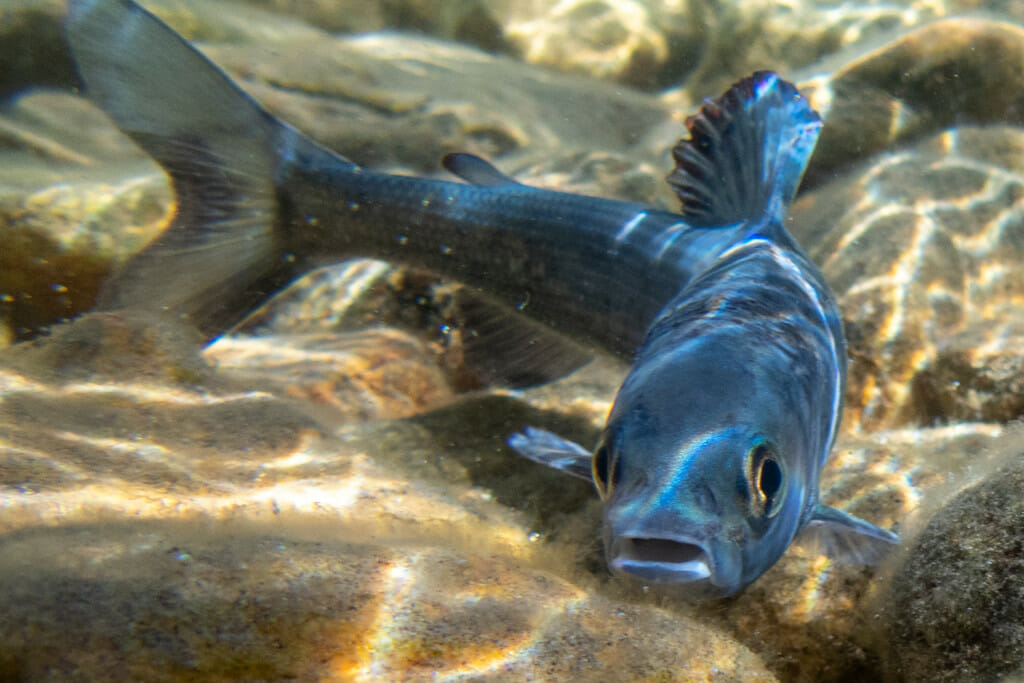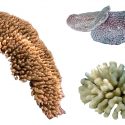Tiny trout? Study finds that several freshwater species are bucking one climate change trend

This Hovsgol grayling from Mongolia is one of the 12 species Solakas and Jensen studied for their new paper, which shares surprising results about the effects of warming waters on fish size. Anne Readel
When it comes to predictions of how climate change will impact fish populations, a new study has found that several species are ‘swimming upstream.’
“One widely expected result of global warming is that animal body size is going to go down,” says Olaf Jensen, an associate professor at the University of Wisconsin–Madison’s Center for Limnology. Shrinking sizes is what Jensen and his collaborators expected to find when they began their analysis of a dozen different species of freshwater salmonids.

Olaf Jensen is an associate professor in the Department of Integrative Biology and Center for Limnology.
Instead, the resulting study — published today in the journal Global Change Biology — told a different, unexpected tale.
Not only are many species of freshwater salmonids — which include trout, whitefish and their relatives — not shrinking in size, several are actually getting bigger.
This trend puts these fishes at odds with what’s known in ecology as “Bergmann’s Rule,” which states that individuals in most species of animals get smaller closer to the Equator and bigger closer to the poles. The reasoning behind the trend, which generally holds true for all sorts of animals, is that evolution favors larger animals in colder climates because they can better retain body heat and regulate their temperature, while smaller animals can readily shed excess body heat at hotter latitudes.
Shrinking in response to rising temperatures is a phenomenon that would seem to be especially relevant for fish.
“Fish don’t have control of their body temperatures,” Jensen explains. And cold-water fishes like the freshwater salmonids would seem to be especially vulnerable to the body-shrinking influence of warmer waters.

Mary Solokas, the lead author of the paper, was a student in Jensen’s lab while conducting this research. She is now a John A. Knauss marine policy fellow with the national Sea Grant program.
For many species, however, that doesn’t always appear to be the case, says Mary Solokas, a former student in Jensen’s lab and current John A. Knauss marine policy fellow with the national Sea Grant program.
Solokas, Jensen and an international team of colleagues combed through decades’ worth of long-term datasets on species of freshwater salmonids in warming climates around the world, from Wisconsin to Finland to Mongolia.
They focused primarily on body-length measurements and found that, over time, only four of their 12 study species were following the predicted script, with current adult fish growing to smaller sizes than fish from past generations.
However, the remaining two-thirds of the species they studied weren’t showing signs of shrinking; they were getting bigger.
“I think the main take-home message from this study is that we cannot assume that the effects of climate change are predictable and negative,” Solokas says, “especially when looking at larger spatial scales.”
She says that their results highlight the complex nature of ecosystem interactions and present a challenge for researchers to account for those intricacies when every part of an ecosystem is directly and indirectly affected by a changing climate.
Jensen agrees. “Climate change is complex, and a simple rule doesn’t come close to capturing all of its impacts,” he says.
For example, while all of the freshwater salmonids Solokas and her team studied live in climates that are warming due to climate change, the majority live in waters currently on the colder side of the fishes’ optimal range. That means, as warming turns up the thermostat in these ecosystems, it moves conditions, for now at least, toward even more suitable temperatures.
However, as these waters continue to warm, temperatures could slide past those preferred conditions, which would begin to stress these cold-water adapted species and lead to negative effects like stunted growth rates and susceptibility to disease.
This is already happening in parts of Wisconsin, for example, where recent research has shown that brook trout populations in some warming streams are struggling, while brown trout, with higher thermal tolerances, are doing fine.
Jensen says this development may have a lot to do with how climate change is reshaping our winters. Typically, winter months are a period of very slow growth for fish. Now, however, ice cover durations are shrinking as water temperatures stay warmer longer into the fall and warm up sooner in spring. The end result could be longer growing seasons for fish, and increased growth rates in aquatic ecosystems throughout the northern hemisphere, Jensen says.
Another hypothesis is that warmer aquatic habitats tend to simply be more productive, with balmy waters encouraging increased growth of the plankton, plants and invertebrates at the base of the food web and resulting in more “fish food” for growing salmonids.
Whatever the mechanisms at play, getting to the bottom of it is the next step in better understanding why freshwater salmonids are getting bigger and how long the trend is likely to last.
Solokas says that this project, with its large time scale and diverse widespread aquatic ecosystems, underscores the importance of open and available long-term datasets to better understand our changing world.
“This project would not have been possible without the countless individuals and research initiatives that collected data year after year and who took the time to work with us to complete this study,” she says.
Tags: climate change, ecology



